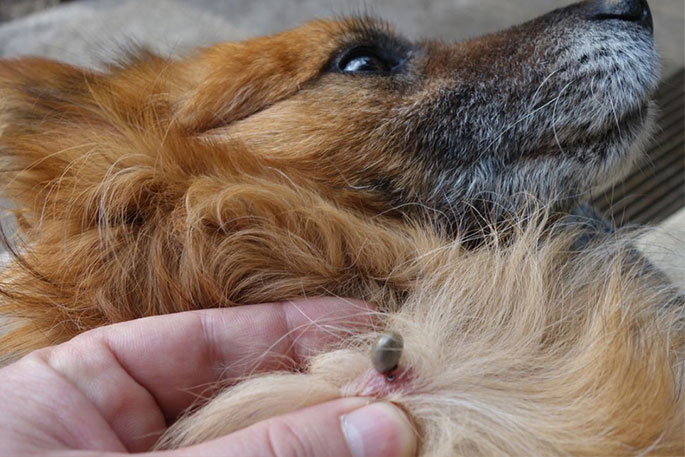
Dealing with pests makes life difficult for your dog – and you. Bugs like fleas and ticks terrorize your dog with bites, and they can infest your house.
We know you want to provide relief for your dog when they face these little invaders. That’s why we’ve compiled this guide on the best ways to tackle them. Read on to learn about four common pests that your pup could face and the easiest way to solve or prevent the problems they bring.
Ticks
Ticks are small parasitic insects that feed on your dog’s blood. Ticks usually live in grassy or wooded areas and can cause a whole host of severe illnesses. These tiny pests can give your dog Lyme disease, Rocky Mountain spotted fever, and babesiosis (a rare disease that affects the red blood cells and is life-threatening).
If you are worried about ticks, you should perform a spot check on your dog every time you come back from a walk or outdoor excursion. But the best way to manage a tick problem is prevention. You want to limit your dog’s exposure to carriers of ticks.
According to this deer fencing site, one of the most common carriers of ticks and Lyme disease is deer. You might consider installing a deer fence around the perimeter of your property to ensure they are kept away from your favourite four-legged friend.
You can also keep your lawn trimmed and use natural pesticide methods on your property to keep these critters at bay.
Fleas
Fleas are every dog owner’s worst nightmare! Fleas are tiny bugs that live on the skin of dogs and cats. Dogs can get these parasites through exposure to other infected animals, whether they’re domestic or wild.
Fleas make your pet itchy. They can also lead to more serious problems like skin infections and anemia if left untreated.
To treat fleas, you need to give your pet flea pills or apply a topical treatment designed to attack fleas on their skin. There are also other treatments like flea shampoo. Only give your pet treatment recommended for them – some dog flea treatments are toxic to cats.
You should also disinfect your home. Make sure to shampoo your carpets, launder upholstery like curtains and cushion covers, and vacuum your whole house. You could also work with a pest treatment professional to be certain your home is clear.
Unfortunately, it can take up to four months to entirely remove fleas from your home. That’s why it’s essential to take steps to prevent your pets from getting them in the first place.
One useful method of prevention is having your dog or cat wear a flea collar. A flea collar is a collar that wards off and kills fleas. It works by spreading a topical ointment on your pet that works as a repellent. It’s a simple and low-cost solution when it comes to preventing fleas.
Wasps
Wasps are a great pain to your dog. If they are stung, they will become swollen and inflamed. Like humans, some dogs can even be allergic to bees and wasps, which makes being stung a life-threatening situation. You might have seen pictures online of dogs with puffy snouts: that’s the result of a bee or wasp sting.
Avoiding bees or wasps on your walk isn’t always possible, because you can’t control the world beyond your house. But be careful when walking in wooded areas where beehives or wasp nests might be.
Worms
Worms are horrible pests for your pup. These parasitic creatures usually attack your four-legged friends’ heart, skin, and intestines.
Common worms that affect dogs include tapeworms, hookworms, roundworms, and heartworms. These all affect your pet in different ways, but worms are one of the most severe problems a dog can face.
Worms are prevented by giving your pet regular de-worming treatments prescribed by a vet. If they do become infected, they can become very unwell and require immediate treatment. Watch out for a loss of appetite, weakness, weight loss, and diarrhea.
Alongside using a preventative treatment, make sure you wash and disinfect your pet’s food bowls regularly and don’t let them eat prey they’ve caught. Worms can be transmitted to your pet through raw meat or infected animals.
Bottom Line
All in all, we know taking care of your pet is your priority. Do your best to prevent little invaders from attacking your fluffy friend and treat them quickly when the pests prevail.
With preventative measures against ticks, fleas, and worms, your pet shouldn’t be pestered by these bugs. Always consult your vet if you think your pet could be ill.



